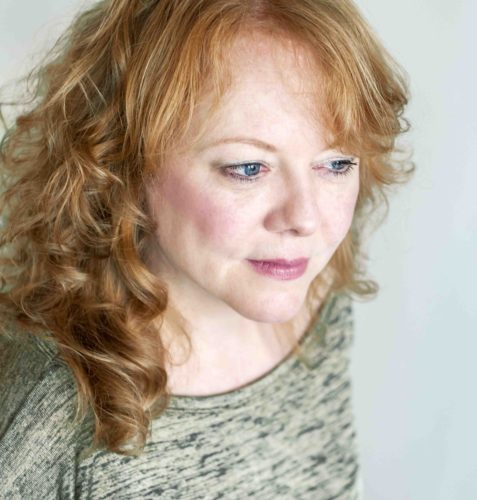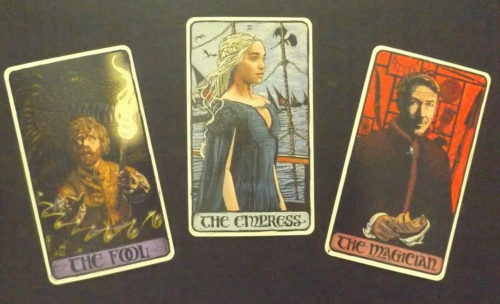ENGLAND — Game of Thrones, that epic, sword-and-sorcery TV series, has its Mother of Dragons.
Liz Dean, a British writer, intuitive and tarot reader, is the Mother of Game of Thrones Tarot.
One might say that it was in the cards that Dean would co-create the Game of Thrones Tarot with San Francisco-area illustrator Craig Coss. Fate nearly derailed her path decades ago as she climbed out of a London cab and promptly forgot the first tarot deck she had ever bought. Such an unfortunate event might have been seen by others as a dire warning to shun the “wicked pack of cards” (as some have referred to tarot).
Dean, however, found her way back to the cards and went on to create the Golden Tarot, Victorian Steampunk Tarot and such books as The Ultimate Guide to Tarot and The Tarot Companion. The culmination of more than a year’s work — a phone-and-email collaboration between Dean and Coss — came to fruition in March with the publication of the Game of Thrones Tarot by Chronicle Books, under official license by HBO, where the series is aired.

The show’s ample use of archetypes and “hero’s journeys” made it a natural choice to meld with tarot, Dean said.
“Game of Thrones has an outrageous quality,” she said during a Skype interview from the Readers Studio, an annual international tarot conference produced by the Tarot School and held in New York City. “When Sean Bean (who played the character Ned Stark) dies, you know they were not afraid to do anything – this character, we’ll just kill him. That gave out a huge signal that anything was possible.
“It’s outrageous but also there are so many hero’s journeys within it. So many. Every single character has this amazing and cathartic transition that goes on and on. You can see that in every single character.”
The deck adheres to tarot tradition by having 78 cards – 22 major arcana, plus 56 minor arcana in suits of cups, coins, spears, and swords. Throughout the deck, illustrations often parallel Rider-Waite imagery even as the minor arcana depict specific series scenes, which are detailed in the small, hardcover guidebook written by Dean.
The guidebook also includes such tarot-reading layouts as “the Red Keep,” “Old Gods of the North,” “I Drink and I Know Things” and others, which Dean created especially for the Game of Thrones deck.
Those who, like Dean, are fans of both the series and tarot will nod in agreement when they see that Daenerys Targaryen, the mother of fragons, is the empress, Petyr Baelish is the magician, the leering sadist Ramsay Bolton is the devil, Lady Brienne is strength, Lord Varys is the hierophant, and Cersei Lannister is the queen of swords. The ten of swords, considered by many as one of the most ominous cards in any tarot deck, depicts the assassination of Jon Snow.
Some cards may be a surprise to fans of the show. Young Arya Stark, and not the character of the Hound, is featured on the death card? One then realizes, however, how many Game of Thrones characters have been ushered out of the world of Westeros at the point of Needle, Arya’s sword.

Liz Dean [Daniella Petkof].
“Tyrion is the fool in this deck because that to me encapsulates the true Tyrion, the higher-self Tyrion, which is the innocent, the one who always believed in dragons and wanted a pet dragon as a child,” she said. “On the fool card that’s why I put him with Daenerys’s dragon — that sense of wonder and risk, you know.
“Whereas with half of Tyrion, he drinks and does all those things — that’s just his ego and his survival mechanisms. When you get to the heart of that character, he is the fool.”
Tarot has been Dean’s path to connecting with what she calls “other layers of consciousness” since she was 20. “I was interested in the Wiccan path from about the age of 11,” she said. “It’s something that I’ve never followed particularly, but I’ve always felt there was an empathy and an awareness there for me, and many friends I’ve met through tarot are very much on that path.
“For me, it’s about sensing chi, about working with intuition, and it’s really been about tarot, because that was my point of connection with these other layers of consciousness that are around for us and that we can have access to for our own self-knowing, our own growth and very much to help others as well. Tarot connected me with that.”
Along with considering herself an “intuitive,” eight years ago Dean came to “feel very connected with angelic presences as well, and I’m also an angelic reiki teacher. I’ve had various experiences in terms of energy and of the spirit. To me place is important in terms of where you live and what you connect with. I live right by the sea (near Newcastle upon Tyne in northeast England), so to me connecting with the elements is a huge thing in terms of a sense of belonging, groundedness, and spirituality. I feel it’s all about being connected, universally connected.”
Dean’s first encounter with tarot came as a child while watching the 1973 James Bond film Live and Let Die, in which the character Solitaire, played by Jane Seymour, gives readings using the Tarot of the Witches deck by Scottish artist Fergus Hall. (The deck has a guidebook written by renowned tarot scholar Stuart R. Kaplan.)
“I was fascinated by that,” Dean said.

When she was 20 and living in a “house share,” a housemate “was on the Pagan path, very much so,” Dean recalled. “She had cards and she showed me. It was the Thoth deck [by Aleister Crowley and Frieda Harris]. She said, ‘Just pick them up.’ They connected with me instantly. I would just lay the cards down and stuff started happening.”
Dean thought the Thoth deck was “amazing, but it isn’t one I connected with after that initiation.” She soon made her way to London to the metaphysical store Mysteries, where she bought the Sacred Rose Tarot by Johanna Gargiulo-Sherman.
“This is a big moment when you go buy your first deck,” Dean said. “It’s a beautiful deck. I was so excited. I got a cab from the train station back home. I got back home and my friend said, ‘Well, where’s your deck, Liz?’ I had lost it in the cab, and there was no way I was going to get it back, so we talked about it, and I just thought, ‘You know what? It’s not the right time.’ I left it for nine months, then I thought ‘I’m going to do this again.’ I went back into London, the same store, bought the Sacred Rose again, and this time I didn’t lose it. It stayed with me, and then I began.
“That taught me something about timing. Now I’ve got a whole collection in a cupboard I call ‘tarot central,’ which is just full of decks. I make my own with artists, but I love collecting as well. I have at least 50, and I collect some historic decks, including an amazing old Tarot of Marseilles.”
Since the day of that second tarot purchase, the cards have been with Dean “in parallel,” even during her 25 years working with big-name London-based publishers commissioning and editing mind/body/spirit books.
18 months ago, Dean was sitting in her seaside home when she got a cold call with a project offer from a staffer with Chronicle Books in San Francisco.
“She didn’t actually tell me what it was on the phone,” Dean said. “She just said, ‘It’s a big project, it’s quite exciting and if you are interested in principle let me email you.’ The email came through five seconds after we put the phone down, and it said, ‘Game of Thrones.’ I read it three times.”
The Chronicle Books people, who knew of Dean’s work creating tarot decks and authoring books, had no idea she was a huge Game of Thrones fan.
“I thought, ‘Have I got this wrong? Is this a joke?’ ” Dean said. “I kind of tentatively typed as I thought, ‘Yes that sounds great. . . . Then I thought, ‘What just happened?’”

Chronicle Books had already signed up Coss, an eclectic artist with an degree from the School of Visual Arts in New York City, and the creator of The Goddess Coloring Book: Traditional Images to Contemplate & Color. On his website, he says “interests that recur in my work include longing, the sacred feminine, the dangers of anthropocentrism, our interconnectivity with the Earth, and the dialogue and tension between opposites such as beauty and power, light and darkness, or passion and discipline.”
That tension of opposites came into play as the pair collaborated by phone and email, avoiding the face-to-face of Skype sessions until after the project was completed.
“Craig has a huge knowledge of symbols,” Dean said. “We had so much enthusiasm together, and different knowledge. That was great because the things we argued about sometimes created something amazing. He did not want to put the zero on the fool card, and I’m going ‘I want the zero!’ In the end, he made the zero the dragon’s eye. Things like that came out of the fact that there was that tension there.
“Craig’s attention to detail was extraordinary. He had me looking at sword hilts for hours, looking at fabric patterns, looking at the symbol on Melisandre’s choker. You start with this huge story arch and think, ‘Ok, how can we align our characters and cards and scenes?’ Every minor arcana card is associated directly with a scene, which is why I wanted to caption all of them, so people could know where they are in the story.
“Craig helped me see how much you could get out of a tiny corner of a symbol or a color. He was absolutely brilliant to work with. We were ‘How do we fit this together so that we’re creating a deck that people can use and get a really good reading from, but we’re being very true to the series, very accurate?’ We were very dedicated – and probably quite fiery with each other.”

Craig Coss [courtesy].
Anyone who visits a metaphysical shop or encounters Stuart R. Kaplan’s massive, four-volume Encyclopedia of Tarot will be awestruck by the proliferation of tarot decks, including any number of pop culture-themed decks ranging from Hello Kitty to Baseball Tarot, and now Game of Thrones.
Does Dean have any reservations about decks that go far beyond traditional medieval and Renaissance imagery?
“No, and I’ll tell you why: to me it’s about maybe reaching out to people who otherwise never would have thought of touching a tarot deck,” Dean said. “That held with steampunk and also particularly with Game of Thrones.
“People who love the series may be very intuitive but never found a deck that really resonated with them, and they may go, ‘Oh wow, I can cross this line here from this series into tarot.’ For me, it’s very much about reaching out to people who may benefit hugely as I have throughout my life with tarot being part of it.”
As a professional tarot reader, Dean has been using the deck for all of her readings for clients since its debut in March — more than 100 readings so far.
“I love it because it’s so direct,” she said. “It gets you right to the heart of the matter.”
The Wild Hunt is not responsible for links to external content.
To join a conversation on this post:
Visit our The Wild Hunt subreddit! Point your favorite browser to https://www.reddit.com/r/The_Wild_Hunt_News/, then click “JOIN”. Make sure to click the bell, too, to be notified of new articles posted to our subreddit.